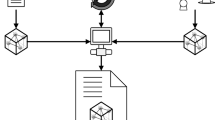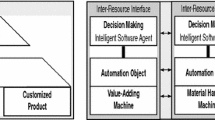Abstract
This article introduces new principles for improving upon the design and implementation of agile manufacturing and assembly systems. It focuses particularly on challenges that arise when dealing with novel conditions and the associated requirements of system evolvability, e.g. seamless reconfigurability to cope with changing production orders, robustness to failures and disturbances, and modifiable user-centric interfaces. Because novelty in manufacturing or the marketplace is only predictable to a limited degree, the flexible mechanisms that will permit a system to adequately respond to novelty cannot be entirely pre-specified. As a solution to this challenge, we propose how evolvability can become a pervasive property of the assembly system that, while constrained by the system’s historical development and domain-specific requirements, can emerge and re-emerge without foresight or planning. We first describe an important mechanism by which biological systems can cope with uncertainty through properties described as degeneracy and networked buffering. We discuss what degeneracy means, how it supports a system facing unexpected challenges, and we review evidence from simulations using evolutionary algorithms that support some of our conjectures in models with similarities to several assembly system contexts. Finally, we discuss potential design strategies for encouraging emergent changeability in assembly systems. We also discuss practical challenges to the realization of these concepts within a systems engineering context, especially issues related to system transparency, design costs, and efficiency. We discuss how some of these difficulties can be overcome while also elaborating on those factors that are likely to limit the applicability of these principles.










Similar content being viewed by others
References
Al-Safi Y, Vyatkin V (2010) Ontology-based reconfiguration agent for intelligent mechatronic systems in flexible manufacturing. Robot Comput Integr Manuf 26(4):381–391
Ashby W (1956) An introduction to cybernetics. Chapman & Hall, London
Banzhaf W (1994) Genotype-phenotype-mapping and neutral variation-a case study in genetic programming. In: Parallel problem solving from nature III, vol 866. Springer, Berlin, pp 322–332
Barata J (2005) Coalition based approach for shopfloor agility. Edições Orion, Amadora
Barata J, Camarinha-Matos L, Onori M (2005) A multiagent based control approach for evolvable assembly systems. In: 3rd IEEE international conference on industrial informatics (INDIN). Perth, Australia, pp 478–483
Berry G, Boudol G (1998) The chemical abstract machine. Theoret Comput Sci 96(1):217–248
Brueckner S (2000) Return from the ant—synthetic ecosystems for manufacturing control. PhD thesis, Institute of Computer Science. Humboldt-University, Berlin, Germany
Bussmann S, Schild K (2000) Self-organizing manufacturing control: an industrial application of agent technology. In: 4th IEEE international conference on multi-agent systems, Boston, MA, USA, pp 87–94
Buzacott JA, Shanthikumar JG (1980) Models for understanding flexible manufacturing systems. AIIE Trans 12(4):339–350
Camarinha-Matos LM, Afsarmanesh H (2004) A multi-agent based infrastructure to support virtual communities in elderly care. Int J Netw Virtual Organ 2(3):246–266
Choi T, Dooley K, Rungtusanatham M (2001) Supply networks and complex adaptive systems: control versus emergence. Oper Manag 19:351–366
Ciliberti S, Martin OC, Wagner A (2007) Innovation and robustness in complex regulatory gene networks. Proc Natl Acad Sci USA 104(34):13591–13596
Edelman G, Gally J (2001) Degeneracy and complexity in biological systems. Proc Natl Acad Sci USA 98(24):13763–13768
ElMaraghy H (2006) Flexible and reconfigurable manufacturing systems paradigms. Int J Flex Manuf Syst 17(4):261–276
ElMaraghy H, AlGeddawy T, Azab A (2008) Modelling evolution in manufacturing: a biological analogy. CIRP Ann Manuf Technol 57:467–472
Frei R (2010) Self-organisation in evolvable assembly systems. PhD thesis, Department of Electrical Engineering, Faculty of Science and Technology, Universidade Nova de Lisboa, Portugal
Frei R, Barata J (2010) Distributed systems—from natural to engineered: three phases of inspiration by nature. Int J Bio Inspired Comput 2(3/4):258–270
Frei R, Barata J, Di Marzo Serugendo G (2007) A complexity theory approach to evolvable production systems. In: Sapaty P, Filipe J (eds) International Workshop on Multi-Agent Robotic Systems (MARS), Angers, France. INSTICC Press, pp 44–53
Frei R, Di Marzo Serugendo G (2011a) Advances in complexity engineering. Int J Bio Inspired Comput 3(4):199–212
Frei R, Di Marzo Serugendo G (2011b) Concepts in complexity engineering. Int J Bio Inspired Comput 3(2):123–139
Frei R, Di Marzo Serugendo G (2011c) Self-organising assembly systems. IEEE Trans Syst Man Cybern C Appl Rev 41(6):885–897
Frei R, Di Marzo Serugendo G, Barata J (2008) Designing self-organization for evolvable assembly systems. In: IEEE international conference on self-adaptive and self-organizing systems (SASO), Venice, Italy, pp 97–106
Frei R, Di Marzo Serugendo G, Serbanuta T (2010) Ambient intelligence in self-organising assembly systems using the chemical reaction model. J Ambient Intell Humaniz Comput 1(3):163–184
Gaugel T, Bengel M, Malthan D (2004) Building a mini-assembly system from a technology construction kit. Assem Autom 24(1):43–48
Gowdy J, Rizzi A (1999) Programming in the architecture for agile assembly. In: IEEE international conference on robotics and automation (ICRA), vol 4, pp 3103–3108
Hanisch C, Munz G (2008) Evolvability and the intangibles. Assem Autom 28(3):194–199
Hollis R, Rizzi A, Brown H, Quaid A, Butler Z (2003) Toward a second-generation minifactory for precision assembly. In: International advances robotics program workshop on microrobots, micromachines and microsystems, Moscow, Russia
Jin Y, Gruna R, Paenke I, Sendhoff B (2009) Evolutionary multi-objective optimization of robustness and innovation in redundant genetic representations. In: IEEE symposium on computational intelligence in multi-criteria decision making, Nashville, USA, pp 38–42
Jin Y, Trommler J (2010) A fitness-independent evolvability measure for evolutionary developmental systems. In: IEEE symposium on computational intelligence in bioinformatics and computational biology (CIBCB), Montreal, Canada, pp 1–8
Katz R (2007) Design principles for reconfigurable machines. Int J Adv Manuf Technol 34:430–439
Kauffmann S (1993) The origins of order: self-organization and selection in evolution. Oxford University Press, Oxford, United Kingdom
Kaula R (1998) A modular approach toward flexible manufacturing. Integr Manuf Syst 9(2):77–86
Kephart J, Chess D (2003) The vision of autonomic computing. IEEE Comput 36(1):41–50
Kirschner M, Gerhart J (1998) Evolvability. Proc Natl Acad Sci USA 95(15):8420–8427
Knowles JD, Watson RA (2003) On the utility of redundant encodings in mutation-based evolutionary search. LNCS, pp 88–98
Koestler A (1967) The ghost in the machine. Hutchinson, London
Koren Y, Heisel U, Jovane F, Moriwaki T, Pritchow G, Ulsoy A, Van Brussel H (1999) Reconfigurable manufacturing systems. CIRP Ann Manuf Technol 48(2):6–12
Kume S, Rizzi A (2001) A high-performance network infrastructure and protocols for distributed automation. In: IEEE international conference on robotics and automation (ICRA), vol 3, Seoul, Korea, pp 3121–3126
Kurakin A (2009) Scale-free flow of life: on the biology, economics, and physics of the cell. Theoret Biol Med Modell 6(6). doi:10.1186/1742-4682-6-6
Leitão P (2004) An agile and adaptive holonic architecture for manufacturing control. PhD thesis, Department of Electrical Engineering, Polytechnic Institute of Bragança, Portugal
Leitão P (2008) A bio-inspired solution for manufacturing control systems. In: IFIP international federation for information processing, vol 266, Springer, Boston, pp 303–314
Leitao P, Restivo F (2008) Implementation of a holonic control system in a flexible manufacturing system. Trans Syst Man Cybern C Appl Rev 38(5):699–709
Marik, V, Vyatkin, V, Colombo, A (eds) (2007) Holonic and multi-agent systems for manufacturing. Springer, Heidelberg
Mehrabi M, Ulsoy A, Koren Y (2000) Reconfigurable manufacturing systems: key to future manufacturing. J Intell Manuf 11:403–419
Niemeyer C (2006) Pick and place in a minifactory environment. PhD thesis, Swiss Federal Institute of Technology (ETH), Zürich, Switzerland
Onori M (2002) Evolvable assembly systems—a new paradigm? In: 33rd international symposium on robotics (ISR), pp 617–621, Stockholm, Sweden
Onori M, Groendahl P (1998) MARK III, a new approach to high-variant, medium-volume flexible automatic assembly cells. Robotica, Special Issue 16(3):357–368
Puviani M, Di Marzo Serugendo G, Frei R, Cabri G (2011) A method fragments approach to methodologies for engineering self-organising systems. ACM Trans Auton Adapt Syst (TAAS)
Rizzi A, Gowdy J, Hollis R (1997) Agile assembly architecture: an agent based approach to modular precision assembly systems. In: International conference on robotics and automation (ICRA). Albuquerque, New Mexico, pp 1511–1516
Rothlauf F (2006) Representations for genetic and evolutionary algorithms. 2nd edn. Springer, Berlin
Rothlauf F, Goldberg DE (2003) Redundant representations in evolutionary computation. Evol Comput 11(4):381–415
Semere D, Onori M, Maffei A, Adamietz R (2008) Evolvable assembly systems: coping with variations through evolution. Assem Autom 28(2):126–133
Shen W, Hao Q, Yoon HJ, Norrie DH (2006) Applications of agent-based systems in intelligent manufacturing: an updated review. Adv Eng Inf 20:415–431
Ueda K (2006) Emergent synthesis approaches to biological manufacturing systems. In: 3rd International CIRP conference on digital enterprise technology (DET), Keynote paper, Setubal, Portugal
Ulieru M, Unland R (2004) Emergent e-logistics infrastructure for timely emergency response management. In: Di Marzo Serugendo G, Karageorgos A, Rana O, Zambonelli F (eds) Engineering self-organizing systems: nature inspired approaches to software engineering, vol 2977 of LNAI, Springer, Berlin, pp 139–156
Valckenaers H, Van Brussel P (2005) Holonic manufacturing execution systems. CIRP Ann Manuf Technol 54(1):427–432
Vallée M, Kaindl H, Merdan M, Lepuschitz W, Arnautovic E, Vrba P (2009) An automation agent architecture with a reflective world model in manufacturing systems. In: IEEE international conference on systems, man and cybernetics (SMC). IEEE Press, pp 305–310
Vrba P (2003) MAST: manufacturing agent simulation tool. In: IEEE international conference on emerging technologies and factory automation (ETFA). Lisbon, Portugal, pp 282–287
Whitacre J (2010a) Degeneracy: a link between evolvability, robustness and complexity in biological systems. Theoret Biol Med Modell 7(6)
Whitacre JM (2010b) Evolution-inspired approaches for engineering emergent robustness in an uncertain dynamic world. In: Conference on artificial life XII. Odense, Denmark, pp 559–560
Whitacre JM (2010c) Genetic and environment-induced innovation: complementary pathways to adaptive change that are facilitated by degeneracy in multi-agent systems. In: Conference on artificial life XII. Odense, Denmark, pp 431–432
Whitacre J (2011) Genetic and environment-induced pathways to innovation: on the possibility of a universal relationship between robustness and adaptation in complex biological systems. Evol Ecol 25:(5):965–975
Whitacre JM, Bender A (2009) Degenerate neutrality creates evolvable fitness landscapes. In: WorldComp-2009, Las Vegas, Nevada
Whitacre J, Bender A (2010a) Degeneracy: a design principle for achieving robustness and evolvability. J Theoret Biol 263(1):143–153
Whitacre J, Bender A (2010b) Networked buffering: a basic mechanism for distributed robustness in complex adaptive systems. Theoret Biol Med Modell 7(20). doi:10.1186/1742-4682-7-20
Whitacre JM, Rohlfshagen P, Yao X, Bender A (2010) The role of degenerate robustness in the evolvability of multi-agent systems in dynamic environments. In: 11th International conference on parallel problem solving from nature (PPSN). Krakow, Poland, pp 284–293
Whitacre JM, Rohlfshagen P, Bender A, Yao X (2011) Evolutionary mechanics: new engineering principles for the emergence of flexibility in a dynamic and uncertain world. Nat Comput. doi:10.1007/s11047-011-9294-5
Wuertz R (ed) (2008) Organic computing. Understanding complex systems. Springer, Berlin
Yu T, Miller JF (2001) Neutrality and the evolvability of boolean function landscape. In: Proceedings of the 4th European conference on genetic programming. Springer, London, pp 204–217
Author information
Authors and Affiliations
Corresponding author
Additional information
Regina Frei received a fellowship for prospective researchers from the Swiss National Science Foundation while this article was written.
Rights and permissions
About this article
Cite this article
Frei, R., Whitacre, J. Degeneracy and networked buffering: principles for supporting emergent evolvability in agile manufacturing systems. Nat Comput 11, 417–430 (2012). https://doi.org/10.1007/s11047-011-9295-4
Published:
Issue Date:
DOI: https://doi.org/10.1007/s11047-011-9295-4




